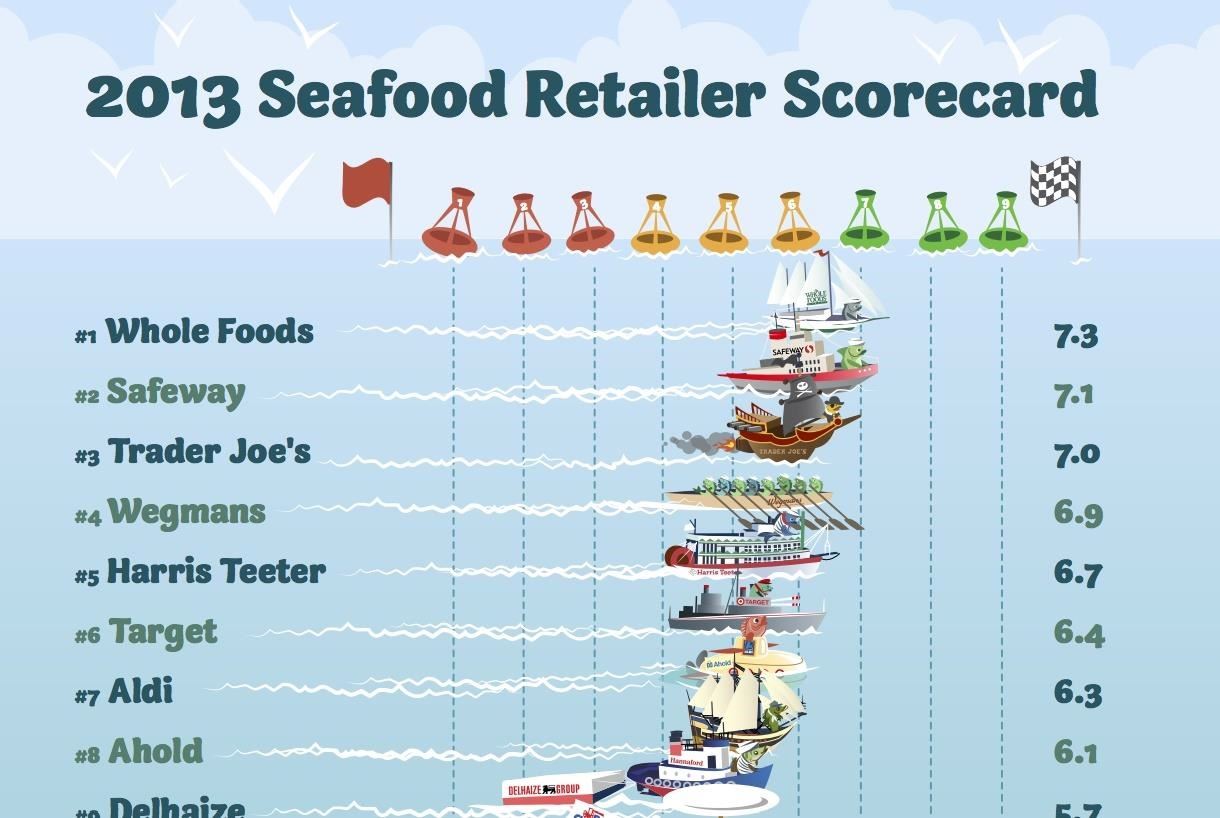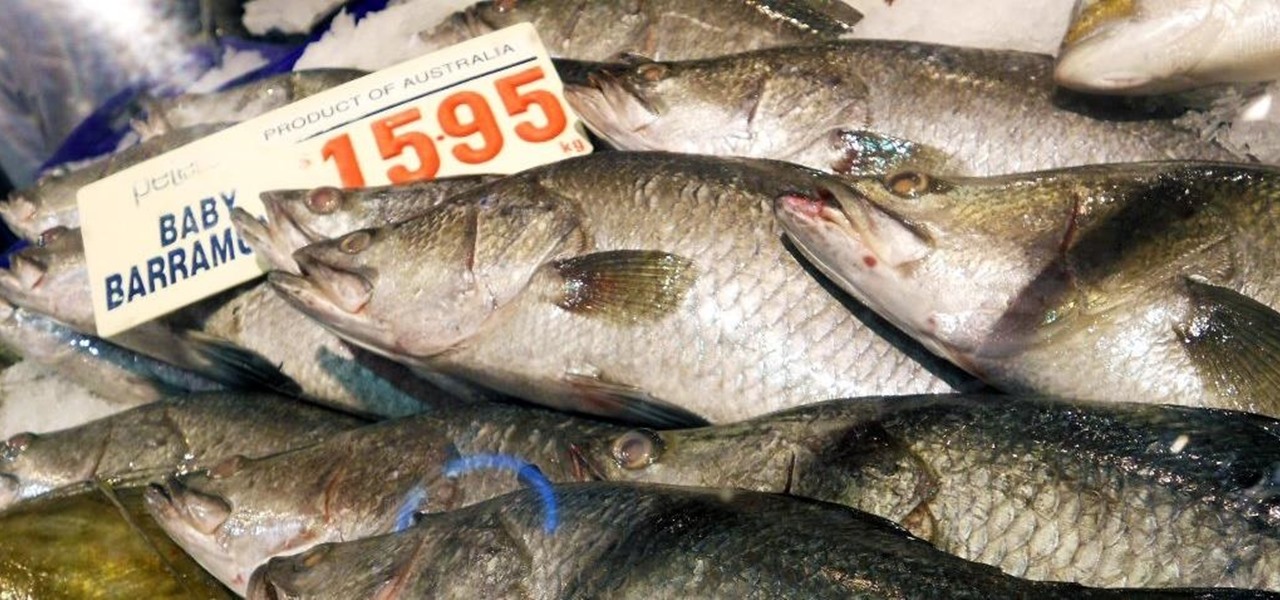Fish is delicious, and as the Harvard School of Public Health points out, incredibly good for you. There are many studies that show regularly consuming a couple of servings of fish per week can help prevent heart disease and may well reduce your chances of stroke, depression, and getting Alzheimer's. After all, there's a reason why fish is called "brain food."

Even if you worry about potentially ingesting mercury or PCBs, since many fish swim in polluted waters, you can sidestep that issue by avoiding the large, predatory fish that generally contain the most mercury.
The National Resources Defense Council has a good list that tells you which fish have the most mercury to the list. The below infographic shows everything more visually (click on the image for the high-res version, or check out the PDF).

However, the times we live in require that we be much more diligent about the fish we eat, since so many species are in danger of being overfished into extinction.
Which Stores Are Committed to Sustainable Seafood?
Thankfully, more and more grocery stores are committing to buying sustainable seafood. A report by Greenpeace last year ranked retailers in four areas, including policy, transparency, initiatives, and red list inventory (that would be the endangered species that they still stock). Whole Foods, Safeway, Trader Joe's, Wegmans, and Harris Teeter occupy the top five spots. You can get the full report here.

However, it's important to keep in mind that defining what's sustainable and what isn't is a slippery business, as The Wall Street Journal points out. If you're lucky enough to live in a place where you still have local fishmongers around, make friends with him or her and ask lots of questions about what kind of fish are and aren't okay to eat when it comes to the environment.

So what do you do if you're in a grocery store that doesn't make info about their seafood easily available? Do you have to give up on eating fish entirely? Not at all. Turns out you have a few options to help you choose fish that will make a great dinner without depleting our oceans even further.
Save Fish the Old-School Way: Use Pamphlets & Websites
Monterey Bay Aquarium has long been at the forefront of educating consumers about what fish are okay to buy and eat. They have educational and informative pamphlets you can download that are specific to each region, as well as one covering the whole United States. They even have a handy sushi guide.

These pamphlets are great for people who don't own smartphones or for folks who prefer looking at a hard copy. Some retailers, like Whole Foods, actually use Monterey Bay Aquarium's guidelines for the labeling of their products, so it's really handy to have on hand.

Meanwhile, GOOD and Always with Honor designed a snazzy set of transparencies based on those same Monterey Aquarium guides. These are slightly prettier to look at and might be good for someone who likes to shop using her tablet as a guide.

The Environmental Defense Fund has a good online guide that's thorough and easy to navigate. They work to establish sustainable methods with fisheries, so they're very up-to-date about the kind of fish and practices fishing trawls actually use.

If you want to learn more about how U.S. fisheries operate and the efforts they make to preserve fish species, check out Fishwatch.gov.
Smartphone Users: Download These Apps
If you're addicted to your smartphone, download one of these handy apps to help you when you're on the hunt for sustainable seafood at a market or a restaurant.
#1. Monterey Bay Aquarium (Android/iOS)
The updated mobile app has lots of handy features: it uses your phone's GPS to direct you to the right regional guide, gives you recommendations for alternates to fish on the "avoid" list, and lets you add restaurants, grocery stores, and businesses who provide sustainable seafood.


You can also search for fish by its Japanese sushi name, which is pretty cool. It's available for Android and iOS devices—and did we mention that it's free?
#2. Marine Stewardship Council (Android/iOS)
This non-profit is behind Whole Foods' sustainable seafood certification program, which is not, however, endorsed by Greenpeace. Their app, which is compatible with Android and iPhones (also free), allows you to search their database for MSC-certified fish.



You can search by species, brand name (e.g. "Safeway shrimp"), or product type ("Taste of the Wild Salmon dog food"). You can even learn which fishery your fish comes from.
#3. SeaChoice (iOS Only)
Based in Ontario, this free iOS app manages to provide a lot of information in an easy-to-digest layout, which makes it handy for people just learning about sustainable seafood. However, it does provide background info on how and where fish were caught, which makes it a good choice for more advanced cooks or even professionals.


Also, it has not been optimized to work with iPhone 5 and newer devices, so you'll get the old school app look, but the database will always be up to date.
Concerned about the state of the oceans and want to do more? Along with educating yourself about sustainable seafood, you can donate to great organizations like Surfrider, which seeks to clean up our oceans and pass laws to protect marine life.
Just updated your iPhone? You'll find new emoji, enhanced security, podcast transcripts, Apple Cash virtual numbers, and other useful features. There are even new additions hidden within Safari. Find out what's new and changed on your iPhone with the iOS 17.4 update.























Be the First to Comment
Share Your Thoughts